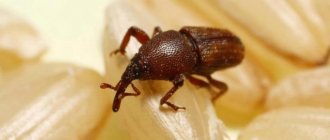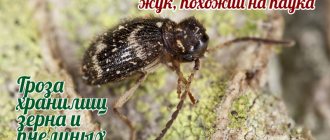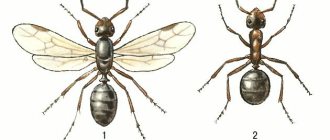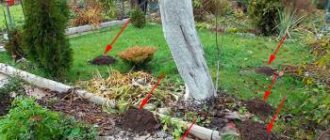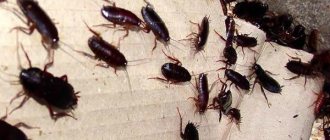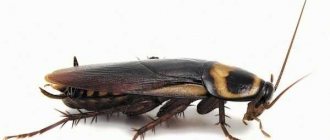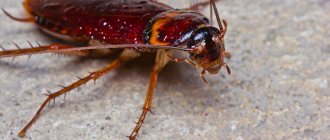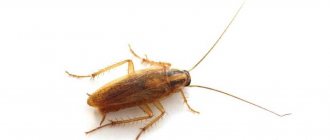The kitchen unit is the area of greatest interest to household pests. In food supplies you can find a huge variety of fauna, including the bread borer, food moth and red flour beetle. The latter is very demanding regarding living conditions, which greatly facilitates the fight against the pest.
Interesting!
Every apartment or house is home to several types of insects. And if they are not visible to the naked eye, this does not mean that they do not exist. American scientists conducted an interesting study, during which they found that on average, about 100 species of arthropods live in one house. Out of 500 rooms, not a single insect was found in only five.
How to quickly remove the Suriname mucoed
The Suriname mucoede is an insect pest that chooses bulk food products for living and breeding. It is found much more often in cereals. The size of the bug rarely exceeds 4 mm, so it is invisible to the human eye.
The main harm is food spoilage. The flour eater leaves behind husks and wet excrement, leading to rotting. When bugs enter the human body, they cause gastrointestinal upset and allergies.
Features of an adult
Developmental schedule of the Suriname mucoed - larva, pupa and adult. It is problematic to notice one insect in a jar of cereals, flies or dried fruits. This is due to the tiny size of the individuals.
Insects live in all types of cereals, flour, dried fruits and nuts. The husk in the glass jar at the bottom shows that there is a Suriname mucoed. A photo of an insect is the only way to carefully examine the pest.
Appearance
The body of the Suriname mucoeda rarely exceeds four millimeters in length. The insect is naturally black or brown. The beetle often pretends to be dead, this is a defensive reaction from humans and animals.
Having discovered black or saffron insects in the cereal, the woman throws out the entire contents of the jar, not thinking that the mucous eaters are safely getting out of the trash can.
Life cycle and reproduction
The Suriname mucoed eater lives for about three years, during which time it manages to produce 100-500 eggs. During one clutch, 15-35 new individuals appear. The insect matures in 1-3 months. At a temperature of 25-28 degrees mucoeds reproduce more actively. The clutch is impossible to notice; the egg size does not exceed 0.1 cm.
Darkness is a favorable condition for the life of the bug. Cereals are stored in cabinets and closed jars; this is an ideal environment for the development of flour eaters.
What harm does
Anyone in the house can have a Suriname mucoed. How dangerous is this pest to humans? Products infested with beetles are unfit for consumption. Millimeter eggs and feces of the mucous eater, entering the body, provoke poisoning. Even heating the cereal in the microwave will not restore its nutritional properties. The product is disposed of and the storage containers are processed.
Bugs in production can ruin tons of cereals. A contaminated product is a reason to visit the sanitary and epidemiological station and a blow to the brand’s reputation. Finding an insect in a packet of rice or flour is unpleasant. To avoid this, the company carefully processes premises and raw materials using high and low temperatures. The beetle is also poisoned with chemicals.
How to quickly get rid of the Suriname mucoed
The flour eater dies at temperatures below -15 degrees. This fact is taken into account when creating granaries. You can also get rid of insects at home. It is impossible to exterminate the mucousworm instantly, but its appearance can be prevented.
Prevention of exposure
A man brings a pest from the store. Failure to comply with the rules for storing cereals leads to the appearance of mucoeds. Preventative measures will help prevent uninvited guests from appearing in the kitchen:
- storing flour and cereals on open shelves in glass jars. Sun rays are an unfavorable factor for the reproduction of insects;
- Place dried fruits and nuts in the refrigerator, low temperatures are detrimental to the flour eater;
- Pre-soak canvas bags for storing cereals in salt water.
Exterminators advise placing purchased cereals in the refrigerator for 30-45 minutes. Low temperatures kill bugs, preventing them from appearing in the house.
Insecticides
How to quickly remove the Suriname mucous eater using chemicals? It is not enough to throw contaminated bulk products into the trash bin. If a large number of mucoeds are detected, treatment of the room is necessary. Insecticides are chemicals that can destroy larvae and adults in a few hours. Preference should be given to aerosols; they are easy to use and disappear quickly.
These remedies will help you get rid of mucous:
Lifestyle and habitat
Mucoed beetles prefer to live in colonies and often settle next to larger pests. This is explained by the fact that it is difficult for them to chew through the chaff to get to the pulp of the grain. We have to use for food what is left from others. If the colony exists independently, yield losses are much less. In the wild, this quality affects the number of insects, but when it gets to the flour mill, the beetle begins to multiply at an incredible speed.
The pest does not like cold weather and dies at temperatures around zero degrees within 20–30 days. Therefore, in natural conditions, he prefers to live in warm regions where there are no harsh winters. In more northern regions, it lives only in heated premises, where it settles together with food. In the absence of sufficient food, the mucous eater migrates as a whole colony. Often attacks and eats insects smaller than it.
The bug does not like bright light. If you suddenly point a flashlight at him, he will pretend to be dead. The mukoeater behaves in exactly the same way if a dangerous predator appears.
Laemophloeus testaceus F.
Placonotus testaceus, Cryptolestes testaceus, Cucujus testaceus
rufous grain beetle
Coleoptera (Beetles) - Coleoptera
The red flour beetle is a small rusty-yellow beetle. The body is covered with hairs. Pest of grain products with high humidity. Inhabitant of mills, bakeries and feed mills.
The author has repeatedly heard how laboratory assistants at grain processing enterprises called all insects similar to the red mulled beetle “saffron milk beetles”, referring primarily to this one, but, as a rule, classifying many small beetles as the red mulled beetle.
In foreign Internet sources, the red mucoed is considered one species with the short-whiskered (red) mucoed; in most domestic sources, the red mucoed is described as a separate species. (Compiled)
Click on photo to enlarge
Morphology
Imago . Body length 1.5 – 2.5 mm. The beetle is rusty-yellow in color, the body is narrow, covered with silky hairs. The head is almost equal in width to the chest, the antennae are equal in length to the body and are widely spaced to the sides. [6]
Beetles have wings and fly well. [3]
The larvae are cream-colored, covered with long hairs, the tip of the abdomen is reddish, with two hook-shaped outgrowths, the length of the adult larva is up to 4 mm.
The pupa is light yellow or cream in color, the body is wide, with long hairs, and at the posterior end there are two spiny outgrowths. The length of the pupa is 1.5-2 mm. [2]
Insects in cereals
No one is safe from the appearance of insects in cereals. They may appear there while the grain is in the elevator or granary. And after the products are packaged and ready for sale, they will end up in our kitchens.
Bugs
It is better not to use cereals where insects have infested, but to throw them away to birds or animals.
Mucoeds
Science knows several types of mucoeds. They are not very different from each other in appearance or in the harm they cause. Some differences exist biologically.
Small bugs in cereals
The bug that most often appears in cereals, the Surinam mucoed, is relatively small in size. Its body reaches 1.8-3.5 millimeters. Its body is elongated and flattened, black-brown in color, the surface of which is matte. Quite short hair growths are adjacent to the chitinous cover.
The loose and flattened head is pushed forward. The mustache, slightly less than half the length of the body, thickens slightly towards the top. In males, on the posterior segments, on the lower part, there is a tiny tooth. These insects do not have the ability to fly.
The red mukoed reaches a length of one and a half to two and a half millimeters. The body is narrow, rusty-yellow in color, covered with hairs. Thin thread-like antennae of the same length as the body. These beetles have the ability to fly beautifully.
The smallest insect in the class of mucoeds is the short-whiskered mucoed. The size of the body reaches only 1.5-2.4 millimeters. Its narrow body is quite thick and has a rusty-yellow color. The chitinous shell has silky hairs. The beetles have two pairs of wings and fly in calm weather on sunny days.
Bread grinder
These insects are the most voracious and not picky bugs in food. Their cylindrical shape and brown body reaches 4 millimeters in length and is covered with hairs.
Moth larvae also spoil cereals
food moth
In addition to beetles, larvae up to 1 cm long and with a dark-colored head can be found in cereal stocks. These are food moth larvae.
Adult butterflies do not have a mouthpart or a functioning digestive system. That's why they don't eat. But the larvae cause no less harm to products than bugs.
Development
Imago . Beetles live up to six months and can fast for up to 2.5 months. Over the course of her life, the female lays several dozen eggs on the foods that the beetles feed on.
The eggs hatch into larvae after a few days.
The development of one generation lasts 70-100 days.
During the year, the red mucous can produce up to 3-5 generations. [6]
Abiotic factors . Reduced humidity is poorly tolerated. It develops better at a temperature of 20-23 ° C and in an environment with high humidity.
The red flour beetle does not develop at a temperature of 12-14 °C: at 16-18 °C the first generation lasts up to 106 days, at 20-23 °C - up to 92. Life expectancy without food also depends on temperature and air humidity. At a temperature of 12-14 °C, beetles can live without food for up to 70 days, at 16-18 °C - up to 62 days, at 25-27 °C - up to 20 days.
As the relative air humidity decreases, the duration of fasting shortens and the insect dies faster. [2]
Related species
Oryzaephilus surinamensis L.
Life cycle
Ambient air temperature and humidity affect insect reproduction. When it gets colder than +16°C, reproduction stops. Under optimal conditions, a female can lay up to 600 eggs in her life, but the average is half that.
The female lays eggs in small piles of 25–30 pieces, not particularly caring whether there is food nearby. They can be found not only in products, but also on the surface of furniture and in the cracks of walls. After about two weeks, mucoed larvae hatch from them. They are light in color and very voracious. In addition to the food familiar to adults, the larvae do not ignore the eggs of other insects.
After 18–20 days, pupation occurs. Interestingly, at this stage the mucous eater acquires a number of spines that protect the pupa from predators. A week later, an adult insect is born.
The lifespan of adults reaches 3 years.
Maliciousness
The red flour beetle is more often found in mills, cereal factories, bakeries and feed mills, where it can clog deep into inaccessible crevices. [6]
It is less common in storage areas, where it feeds preferably on rotting flour, cereals and grains damaged by other pests. [1] Marked on corn. [7]
Accumulating in large colonies in a stored product, they can increase its humidity and contaminate it with larval skins and excrement. They are also dangerous because they chew through sieves. [1]
Dry grain cannot damage because it cannot develop in grain with a moisture content of less than 15%.
In addition to grain reserves, the pest is also found under the bark of various trees, where its larva devours the larvae and pupae of bark beetles and other pests. [9]
Pesticides
To localize the pest in open spaces, containers and grain
New powerful insectoacaricide:
Working folk methods: which ones to choose?
Those who consider chemicals too dangerous and the disposal and destruction of insects by lowering or raising temperatures are not so effective should try to solve the problem with the help of folk remedies. Recipes for some of them are below:
- Table vinegar. All surfaces infected with the bug are treated with a vinegar-based water solution, along with the simultaneous disposal of cereals and flour damaged by pests.
- Bay leaf, pepper, garlic, sulfur. All of these are products whose smell is feared not only by flour bugs (the photo below will prevent you from making mistakes in identifying pests), but by other types of insects.
- Antiseptics of natural origin - chamomile or calendula can also repel pests.
An interesting option that allows you to forget, if not forever, then for a long time, what bugs in cereals are (a photo will help you correctly identify the type of each) is a trap based on boric acid.
Bait works on a simple principle: insects are attracted to the bait. Hungry bugs try a poisoned treat, become infected with toxins and poison the rest of the colony.
To prepare the bait, boric acid is mixed in a container with powdered sugar, semolina, honey, and syrup. Treats will only attract pests if they are fresh. It is recommended to use traps when children and pets are not at home, placing them in insect habitats.
Control measures
Preventive control measures
- Preparation of storage facilities
before receiving and placing grain for storage: cleaning and subsequent disinfestation by wet or aerosol treatment; comprehensive inspection of all objects for contamination. - Grain preparation
: drying the grain to a dry or medium dry state, cleaning it from impurities and broken grains; maximum reduction in grain temperature; spraying grain with contact insecticides. - Infestation
by insects and mites must be monitored continuously. [8]
Destructive control measures in grain, products and raw materials
Physico-mechanical methods of controlling pests of grain stocks
:
- Cooling of grain, products of its processing, etc.
- Heating of grain, products of its processing, etc.
- Cleaning of grain, products of its processing, etc.
Cooling grain and products, as well as heating grain under established conditions, leads to the death of pests, and cleaning ensures a reduction in infestation.
Chemical methods of control
The following insecticides and methods are used for chemical disinfection of various food products:
I. Preparations based on hydrogen phosphorous (phosphine)
II. Contact insecticides
The grain is treated during transportation with aqueous solutions of preparations or directly with emulsion concentrates.
Destructive control measures in warehouses and production facilities:
One of the important conditions for preventing the contamination of grain and products by pests at enterprises is the good condition and cleanliness of warehouse and production premises.
Chemical methods of control
- Gas disinfestation (fumigation, gassing)
- Wet disinfection of premises (wet disinfestation)
- Aerosol disinfection of premises (aerosol disinfestation)
- Combined use of the methods described above. [4][5]
Prevention of bugs
In order not to fight pests, it is better to protect yourself from their appearance and reproduction in advance. General advice is to keep it clean and ensure that cabinets are periodically ventilated.
If your furniture is quite airtight and the air in it does not circulate well, do regular ventilation by simply opening the cabinets for a short time:
- Try not to make large reserves. This, of course, will not protect you from pests, but it will significantly save your money; if a bug does settle in, you will have to get rid of the products.
- Give preference to airtight glass or plastic containers with tight lids. Only such banks will not be defeated by Khrushchev.
- If you can’t deny yourself this and still stock up on food in bags, then use dust. Herbal dust can be bought at the market, less often in a store, in the insect control department. This product must be sprinkled on the floor, under the bags. Bugs are not suitable for it, and it is absolutely safe for human health.
- Try to differentiate products rather than storing everything together on one shelf. For example, try to keep wet dried fruits away from cereals.
- Use a folk remedy for prevention – garlic. You can put a clove of garlic at the bottom of a jar of cereal. And between the jars, place dried bay leaves, which parasites cannot tolerate.
- If you still store cereals in fabric bags, then “salt” such containers. To do this, you need to prepare a saline solution, about a couple of tablespoons per 1 liter of water, and soak the bags in it. After half an hour, take them out and dry them. Parasites try to avoid such salted bags.
If you still store cereals in fabric bags, then “salt” such containers
Meet the Beetle
The mukoed belongs to a large group of household parasites (class of flat beetles of the Coleoptera order). Its flattened and long body is tiny, barely reaching 2.5-3.5 mm in length. The chitinous shell is brown in color with different shades - from darkish to lightish. The bug has small antennae and a flattened head.
The mucoed is an insect that prefers warmth. It begins to multiply rapidly at temperature parameters of +25-27⁰C with a humidity of about 65%. In favorable places, 35-40 days are enough for the bug to fully develop. When the temperature drops to +16⁰C, the beetle stops reproducing, and at 0⁰C and below it quickly dies.
Why is it dangerous?
The pest poses the greatest threat to food supplies (flour/grain/nuts). The parasite does not disdain vegetable warehouses and stocks of dried fruits. This pest is voracious and can quickly destroy almost all stocks. The mucoed is also distinguished by its high fertility. A female beetle lays up to 500-700 eggs at a time. The masonry is made on the food components where the individual is currently located.
How the parasite gets into homes
The mucoed is a native of the wild, where its habitat is rotten stumps and tree bark.
But in natural conditions, the bug does not live long - at the first convenient opportunity, it moves to more favorable conditions for it - feed factories, bakeries, mill buildings, barns, etc. The flour beetle makes its way into our homes in several ways:
- from markets in bags (bags) with flour or various cereals;
- in packages with food for four-legged pets (they are usually found in food of poor quality);
- independently, by flight, if the houses are located near enterprises.
When this bug is first detected, it is necessary to take active measures to destroy it. A mucoed on its own will not leave its favorite territory, where there are conditions for its residence and reproduction.
Mucoeds have another unusual feature. The bug, as soon as you touch it, immediately tightens its paws and pretends to be dead. Housewives, believing that the insect is dead, sweep it up and throw it in the trash. From there, the mucous crawls out safely after some time and returns to its habitat.
Additional questions
Why are bugs in cereals dangerous?
The beetles are not dangerous, but the eggs and larvae reduce the nutritional value of the product. Waste sometimes contains antigens that can lead to allergic reactions.
The greatest health risk is posed by insects called flour beetles or flour beetles, which live in flour or semolina. Their excrement is difficult to distinguish from particles of this food. They may cause an allergic reaction or worsen asthma symptoms.
If a beetle called a flour beetle is found in the cereal, then mold may get into the food. These insects usually live in conditions of high humidity. In this case, intoxication or poisoning may occur, especially if the grains are consumed for a long time.
If there are bugs in the cereal, can it be eaten?
Washing is not enough to safely eat such grains. The beetles actively reproduce and leave excrement. If there are few of them, then whether to cook from the product after washing and drying is at the discretion of the housewife.
If beetles live in cereals and spices and crawl all over the house, the situation becomes more complicated. If grains are heavily infected, their taste properties are lost. Insects eat their valuable base, but bitterness remains. If pests have been in the products for a long time, chitinous skins, empty cocoons, and excrement remain. They are dangerous for humans, as eating them can cause poisoning.
When using flour after sifting, difficulties arise. Insects eat valuable protein, so kneading it becomes almost impossible.
It is necessary to store cereals in containers so that beetles do not spread to food at high speed
It is equally important to always keep the kitchen clean - follow general hygiene rules and clean regularly. If you suppressed the insect infestation, but did not take serious measures, the pests will appear again
What to do if there are bugs in the cereal, can it be consumed or cleaned of pests?
My friend has been struggling with a sensitive problem for a long time. There are always bugs in her cereal cupboard. In search of an answer to the question of how to get rid of bugs in cereals, we decided to try all known methods. As they say, in war all means are good.
Effective ways to fight
Before you start expelling mucoids from your home and using a certain remedy, it is necessary to carry out preparatory work:
- Clear all cabinets and tables of food.
- Remove dishes and other food items.
- Treat kitchen surfaces (both outside and inside) with a vinegar solution (25 ml of vinegar per liter of water).
- Pour boiling water over the cracks of the cabinets to kill bugs hidden in the chips (carry out this activity if you are sure that the boiling water will not damage the furniture).
- Empty all jars in which bulk products are stored, rinse thoroughly with soapy water, and then scald with boiling water.
- If food supplies were kept in canvas or linen bags, empty them and soak them in a saline solution.
After preparation, you should begin the direct destruction and expulsion of mucous beetles from your favorite territories. There are many ways to do this.
Use of insecticides
Chemicals that are unsafe for humans and pets should only be used when there is a large population of bugs.
The following drugs showed the best results in pest control:
Source
| Favorable t (o C) | 20-23 |
| Min. t development ( o C) | 14 |
| Optim. ambient humidity, % | more than 15 |
| Fertility (pcs) | up to 100 |
| Generations per year | 3-5 |
| Larva (mm) | up to 4 |
| Pupa (mm) | 1,5-2 |
| Imago (mm) | 1,5-2,5 |
| Transformation | Complete |
| Full cycle | 70-100 |
| Imago | OK. 180 |
Preventive actions
No one is safe from the invasion of the Suriname mucoed. To minimize the occurrence of the ubiquitous household pest, follow a number of simple preventive measures:
- maintain cleanliness in the kitchen;
- store cereals in a tightly closed container;
- dried fruits must be kept in the refrigerator;
- ventilate the kitchen frequently;
- freshly purchased bulk products should be kept in the freezer for 2-3 days before being sent for storage;
- ensure dryness in the kitchen, do not allow moisture to arise;
- periodically conduct a thorough audit of food products;
- Always keep garlic cloves, bay leaves, sprigs of dry chamomile or rosemary in your kitchen furniture;
- Treat kitchen furniture with vinegar solution 1-2 times a month.
Have you ever had to fight a garden flour beetle?
Was the caseNever
Flour-eating bugs are dangerous and destructive parasites. Once infected, food becomes completely unsuitable and dangerous for consumption. Therefore, when this insect first appears, it is necessary to immediately begin to completely expel it from the apartment.
